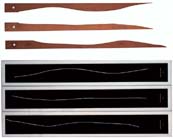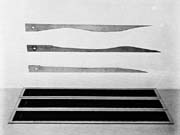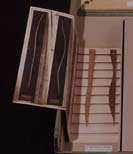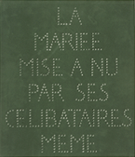click to enlarge

Marcel Duchamp, 3 Standard
Stoppages, 1913-14
© 1999 Succession Marcel Duchamp, ARS, N.Y./ADAGP, Paris
Marcel Duchamp’s first box, the Box of 1914, included the seminal note that led to one of the artist’s most important works — the 3 Stoppages Étalon(or 3 Standard Stoppages): (1)
The Idea of the Fabrication
horizontal
–If a threadone meter longfalls
straight
from a height of one meter on to a horizontal plane
twisting as it pleases and creates
a new image of the unit of
length —
— 3 examples obtained more or less
similar conditions
:considered in their relation to one another
they are an approximate reconstitution of
the unit of length
The 3 standard stoppages are
the meter diminished
(See illustrations 1A & 1B, showing the 1914 Box and the 3 Standard Stoppages note.) The Green Box of 1934 includes the first paragraph of this statement and also the additional key note: “3 Standard Stops=canned chance.” (See illustrations 2A & 2B,showing The Green Box and its reproduction of the earlier note for 3 Standard Stoppages).(2)
click images to enlarge

Illustration 1A
© 1999 Succession Marcel Duchamp,
ARS, N.Y./ADAGP,Paris
Illustration 1B
© 1999 Succession Marcel Duchamp,
ARS, N.Y./ADAGP,Paris
Illustration 2A
© 1999 Succession Marcel Duchamp,
ARS, N.Y./ADAGP,Paris
Illustration 2B
© 1999 Succession Marcel Duchamp,
ARS, N.Y./ADAGP,Paris
Duchamp then made the object, listing the date as “1913-14” and insisting that he had followed the protocol of his note. He claimed that he had dropped three pieces of string, each exactly one meter long, each from a height of exactly one meter, and each only once, onto a canvas. He then glued each string to the canvas in the exact position of its chance fall. Photographs of the three canvas strips appear in the Box of 1914.
When working on his painting Tu m’ in 1918,Duchamp made wooden templates in the shape of each string’s pathway. (See illustrations 3A, 3B & 3C for Tu m’ and details of the Stoppages.)

Illustration 3A
© 1999 Succession Marcel Duchamp, ARS,
N.Y./ADAGP, Paris
![]()
Illustration 3B
© 1999 Succession Marcel Duchamp,
ARS, N.Y./ADAGP, Paris

Illustration 3C
© 1999 Succession Marcel Duchamp,
ARS, N.Y./ADAGP, Paris
click to enlarge

Illustration 4
© 1999 Succession Marcel Duchamp, ARS,
N.Y./ADAGP, Paris
In the summer of 1936, as he was working on the restoration of The Large Glass, Duchamp cut each of the canvases down to its current width and glued each to a glass plate. A comparison of the 1914 photos with the current strips on glass — which are now at the Museum of Modern Art (MOMA) in New York — reveals no differences in the length or form of any of the strings. We may therefore assume that MOMA’s object represents Duchamp’s original construction.(See illustration 4 for the 3 Standard Stoppages in situ at the Museum of Modern Art.)
Calvin Tomkins describes the central importance of the 3 Standard Stoppages in Duchamp’s work and career:
Duchamp would come to look upon the stoppages as one of the key works in his development as an artist. “In itself it was not an important work of art,” he [Duchamp] said, “but for me it opened the way — the way to escape from those traditional methods of expression long associated with art. I didn’t realize at the time what I had stumbled on. When you tap something, you don’t always recognize the sound. That’s apt to come later. For me the Three Standard Stoppages was a first gesture liberating me from the past.”
(However one chooses to interpret this work and its meaning, one can only appreciate the deep and delicious irony,the provocation of thought, and the tweaking of the most literal of all conventions — for the meter was defined by the French revolutionary government in 1791 as a new and liberating device, based on the size of the earth itself [defined as 1/10,000,000 of the quadrant of the earth’s circumference measured from the North Pole through Paris to the Equator], and therefore constant, unvarying, and capable of serving all people as an absolute standard. [In fact, The International Bureau of Weights and Measures long kept, at rigidly constant temperatures to prevent change by expansion and contraction, an actual standard meter,defined as the distance between two lines etched into a bar of 90 percent platinum and 10 percent iridium]. [See illustration 5, showing the standard meter.] How lovely, in an early 20th century age that was introducing concepts of chance and higher dimensionality into the previous exactness of Newtonian physics, to tweak this rigidity by defining a new meter based on three separate infusions of chance imposed upon an object one meter long!)
click to enlarge

Illustration 5
Standard scholarship on the Standard Stoppages simply repeats Duchamp’s descriptions of his modus operandi — arguing about meanings and intentions at great length and with great erudition,but never questioning the actual mode of manufacture, or carefully examining the original object to verify Duchamp’s claims. Nonetheless, a current of doubt has crept into the literature, and into the talk of Duchamp scholars and aficionados, for a definite and interesting reason: each of Duchamp’s three strings (see figures) follows a smooth and gentle curve, with broad and limited undulations and no large “wiggles,” crossover loops or other sharp irregularities. The three pathways are, in fact, quite regular and appealing in their gradual and limited meandering.
Many people — perhaps, for the fun of it, or to feel some affinity with Duchamp, rather than from any suspicion about the master’s standard protocol — have tried dropping strings of the same apparent composition following Duchamp’s method: regular tailor’s thread, one meter long, dropped from a height of one meter. And, to put the matter succinctly, no one (at least anecdotally) has presented evidence that they have been able to replicate any of Duchamp’s gentle patterns,even once. Light string just will not fall into such a regular pattern when dropped from such a height. Try as many times as one may, the actual results always produce a pathway far more jerky and wiggly than anything obtained by Duchamp in any of his three stated attempts.
For example, a well known and oft repeated story states that Duchamp’s friends, composer John Cage, and artist William Anastasi each tried to drop string numerous times following Duchamp’s protocol, and never could match any of his patterns closely because the actual drops always exceeded the pathways of the stoppages in degrees of irregular wiggling. We do know that when Walter Hopps and Arturo Schwarz both asked Duchamp how they should make the pathways of the strings for their reproductions of the stoppages (they were having trouble replicating the pathways even by trying to lay out the string in the “right” patterns by hand because the string always jumped and wriggled in other parts as they tried to lay out one part in Duchamp’s gentle arrangement) — Duchamp advised them simply to lay out the string along and against the path of the wooden templates (residing in MOMA).(3)
Yet Duchamp continued to insist, vehemently and even when questioned closely (and perhaps in the light of such suspicions),that he had followed the stated protocol of dropping each string — “exactly” one meter in length — just once, and gluing it where it had landed “à son gré” (by its own will). For example,in an interview with the young Carroll Janis (who has told us that he pressed the point because he had developed similar doubts and puzzlement): (4)
Marcel: It could be done only once. Also I like that it could only be done once and no more. That’s like an experiment or something. I liked it very much …
Carroll: I wanted to ask you about the lines.Were they dropped according to the laws of chance, and the first position they fell, they were? In other words, it was strictly that one drop and it wasn’t any drop until you felt you had achieved this sort of effect?
Marcel: No, there were three drops.
Carroll: Yes, I know there were three separate drops, but each was one drop?
Marcel: Absolutely. Also, that’s the point…
Carroll: Marcel, did you drop each one just once, or did you keep on dropping them?
Marcel: Just once, just once. Don’t recall there was any mishap.
We have also tried to replicate Duchamp’s smooth and gentle patterns by hundreds of frustrating drops, using all kinds of threads, including some (of much greater weight or thickness, or covered with various stiff surfaces) that one might consider more apt than Duchamp’s threads to fall in such regular patterns — different materials of cotton, silk and wool; different weights, different waxed and unwaxed surfaces; including forms of “regular tailor’s thread” (Duchamp’s words and claim) that would have been available in France, during 1913. We also never came close to replicating the smooth patterns of the stoppages. Our drops were often dramatically affected by the variety of slight differences in initial conditions. Sudden whipping air currents or the uneven timing of the opening our two thumbs (holding the thread at each end in-between the two forefingers before releasing each thread) created even more extreme wiggle patterns. The elastic construction of the thread itself (in actuality, a bundle of smaller gauge threads) creates differences in overall length (due to increases or decreases of pulling and releasing tension, which results from stretching each thread into its horizontal position in preparation for each one meter drop).(5)
Trying to establish stability and precision in the act of holding and dropping threads was maddening (and therefore hilarious) and impossible.(6)
We then asked conservators at MOMA, Erika Mosier,Pat Houlihan, and Christopher McGlinchey, to examine the original object,and they solved the old problem, with almost embarrassing simplicity, in a simple and direct way that any even casually suspicious scholar could have discovered at any time. Duchamp, in fact, followed a procedure quite contrary (both in actual action and implied significance with respect to the role of chance) to his stated protocol to make the original object now on display. If one turns over each of the canvases and studies the back through the glass mounts, the solution emerges clearly — and one can only laugh and say something like: “oh, so that’s what he did to get such smooth patterns.” Each of the strings begins on this obverse side, extends through a needle hole to the recto side of the display,meanders for a meter along the recto (making the path of the stoppage itself), and then goes through another needle hole back to the obverse,where it extends further for a few additional centimeters (making a much longer total thread length than Duchamp’s claim of an “exact” one meter!).(See video and illustrations 6A, 6B, 6C & 6D for recto and verso views. Also see, illustration 6E for visualization of a needle’s path through the canvas.>
click images to enlarge

Illustration 6A
© 1999 Succession Marcel Duchamp,
ARS, N.Y./ADAGP, Paris
Illustration 6B
© 1999 Succession Marcel Duchamp, ARS,
N.Y./ADAGP, Paris
Illustration 6C
© 1999 Succession Marcel Duchamp,
ARS, N.Y./ADAGP, Paris
Illustration 6D
© 1999 Succession Marcel Duchamp, ARS,
N.Y./ADAGP, Paris

Illustration 6E
Obviously Duchamp made the pathways purposefully by sewing– that is, he sewed through the obverse, left a meter of string on the recto side, and then sewed back through to the obverse. He could then put tension on the string by holding both of the obverse ends and (along with the potential counter weight of needles)produce any pattern of his own choice on the recto side.
In his characteristic, instructive and playfully challenging way, Duchamp did not make his actual protocol (so contrary to his stated procedure) obvious, but he didn’t hide his workings very strictly either — as if he intended to challenge us by saying: “I have hidden this in plain sight. I have given you deliberate hints. Why don’t you be critical and look carefully, and not just believe what creative people or authoritative scholars (and docents giving public tours at MOMA) tell you.” To wit:
1. He could have mounted the canvases on an opaque surface, — wood, cardboard — thus making the holes for sewing through, and the extensions of string on the verso sides, invisible.But he glued the canvases on glass, so that one could see his procedures through a glass, and rather clearly.
2. Once one has the right hypothesis,the whole “experiment” becomes even funnier, and emerges more as a test of the chance occurrence of critical powers and human discovery than a test of the blank rules of chance within objective nature. Once one realizes what Duchamp actually did, several features of the work, previously unnoticed,point to the true procedure. For example, one can now actually see (in the visible relief impression — pressing up from the back into the rectoside) that the pathways of the extensions of the strings on the versoside (see again illustrations 6A, 6B, 6C, 6D) have been right there, and fully visible, all along, not only in the work on display at MOMA but also in Duchamp’s 300 copies of the Boîte en Valise where a miniature version of the 3 threads, their six ends (on the recto side, see illustration 7) and their faint but visible extensions (pushing up from the verso side) lie at the bottom of the box ready to be seen.(7)
click to enlarge

Illustration 7
© 1999 Succession Marcel Duchamp,
ARS, N.Y./ADAGP, Paris
Also, importantly, Duchamp’s threads are decidedly more than a meter in length, a fact that he also leaves right before us — to be seen in both recto and verso. Moreover, one can finally understand why the string “ends” do not fray at all on the rectoside (as ordinary string always does at a cut end). These are not string ends at all, but places where a continuing string passes through a hole to the other side (see again illustrations 6A, 6B, 6C, 6D).
Finally, another delicious irony in closing:perhaps we can now understand the real reason behind Duchamp’s naming this piece a “stoppage,” literally an “invisible mending.” Scholars like Camfield have assumed that he meant to designate his “amending” of the meter. But what then is invisible about the effort — given the object
itself and Duchamp’s published protocol? The object, we now understand,truly, and absolutely literally, represents a genuine “invisible mending”– a pathway done by sewing, but hidden in plain sight.
Notes
 1.From the Box of 1914 at The Art Institute of Chicago; in Arturo Schwarz’ Duchamp Catalogue Raissoné (Revised edition, New York: Delano Greenidge Editions, 1997) this note is listed as Note 96.
1.From the Box of 1914 at The Art Institute of Chicago; in Arturo Schwarz’ Duchamp Catalogue Raissoné (Revised edition, New York: Delano Greenidge Editions, 1997) this note is listed as Note 96.
 2.Richard Hamilton, The Bride Stripped Bare By Her Bachelors, Even(New York: Percy Lund, Humphries and Co. Ltd, 1960).
2.Richard Hamilton, The Bride Stripped Bare By Her Bachelors, Even(New York: Percy Lund, Humphries and Co. Ltd, 1960).
 3.We are grateful to Pat Houlihan, Associate Conservator of Sculpture at MOMA,for pointing out the visit to MOMA by Hopps and others re: their construction of 3 Standard Stoppages reproductions.
3.We are grateful to Pat Houlihan, Associate Conservator of Sculpture at MOMA,for pointing out the visit to MOMA by Hopps and others re: their construction of 3 Standard Stoppages reproductions.
 4.From a private conversation with Carroll Janis and Rhonda Roland Shearer,1998.
4.From a private conversation with Carroll Janis and Rhonda Roland Shearer,1998.
 5.We used thread from varying size spools (large and small) including waxed thread loosely wrapped around 12″ flat cardboard.
5.We used thread from varying size spools (large and small) including waxed thread loosely wrapped around 12″ flat cardboard.
 6.Box Notes (1934) but specifically ddressed the technical aspect of “early chaos theory” first developed by Henri Poincaré (who died in 1912). Poincaré stated that chance systems sensitive to small, initial conditions, like the weather or roulette, are affected by 1) air currents 2) muscle control (as in no two spins of a roulette wheel can ever be exactly controlled to be alike) and 3) gravity.(Henri Poincaré, The Foundations of Science, New York: The Science Press, 1921. See chapter,”Chance.” In the Green Box Notes, Duchamp refers to the same three initial conditions that Poincaré mentions as his examples. For his three
6.Box Notes (1934) but specifically ddressed the technical aspect of “early chaos theory” first developed by Henri Poincaré (who died in 1912). Poincaré stated that chance systems sensitive to small, initial conditions, like the weather or roulette, are affected by 1) air currents 2) muscle control (as in no two spins of a roulette wheel can ever be exactly controlled to be alike) and 3) gravity.(Henri Poincaré, The Foundations of Science, New York: The Science Press, 1921. See chapter,”Chance.” In the Green Box Notes, Duchamp refers to the same three initial conditions that Poincaré mentions as his examples. For his three
experiments in chance Duchamp writes:
Wind — for the draft pistons
Skill — for the holes
Weight — for the standard-stops
to be developed —
In a second note, Duchamp correlates the “weather” with his Bride in The Large Glass as sensitive to initial “differences” — just as Poincaré correlates the “weather” as “sensitive to small differences.” (See Poincaré,The Foundations of Science). Duchamp would have likely learned about Poincaré’s insight into chance systems from Poincaré’s popular writings.The artist Cleve Gray, translator of Duchamp’s White Box Notes, was told “many times” by Duchamp that “Poincaré was at the bottom of everything he [Duchamp] was doing” (Private conversation 1997 Rhonda Roland Shearer and Cleve Gray.)
(For above two notes, see Richard Hamilton, The Bride Stripped Bare By Her Bachelor, Even, New York: Edition Hansjörg Mayer, 1976.)
 7.An important topic for Duchamp, he, in fact, titled an exhibition,NOT SEEN and/or LESS SEEN of/by MARCEL DUCHAMP/RROSE SÉLAVY 1904-1964,Cordier & Ekstrom Gallery, 1965.
7.An important topic for Duchamp, he, in fact, titled an exhibition,NOT SEEN and/or LESS SEEN of/by MARCEL DUCHAMP/RROSE SÉLAVY 1904-1964,Cordier & Ekstrom Gallery, 1965.











